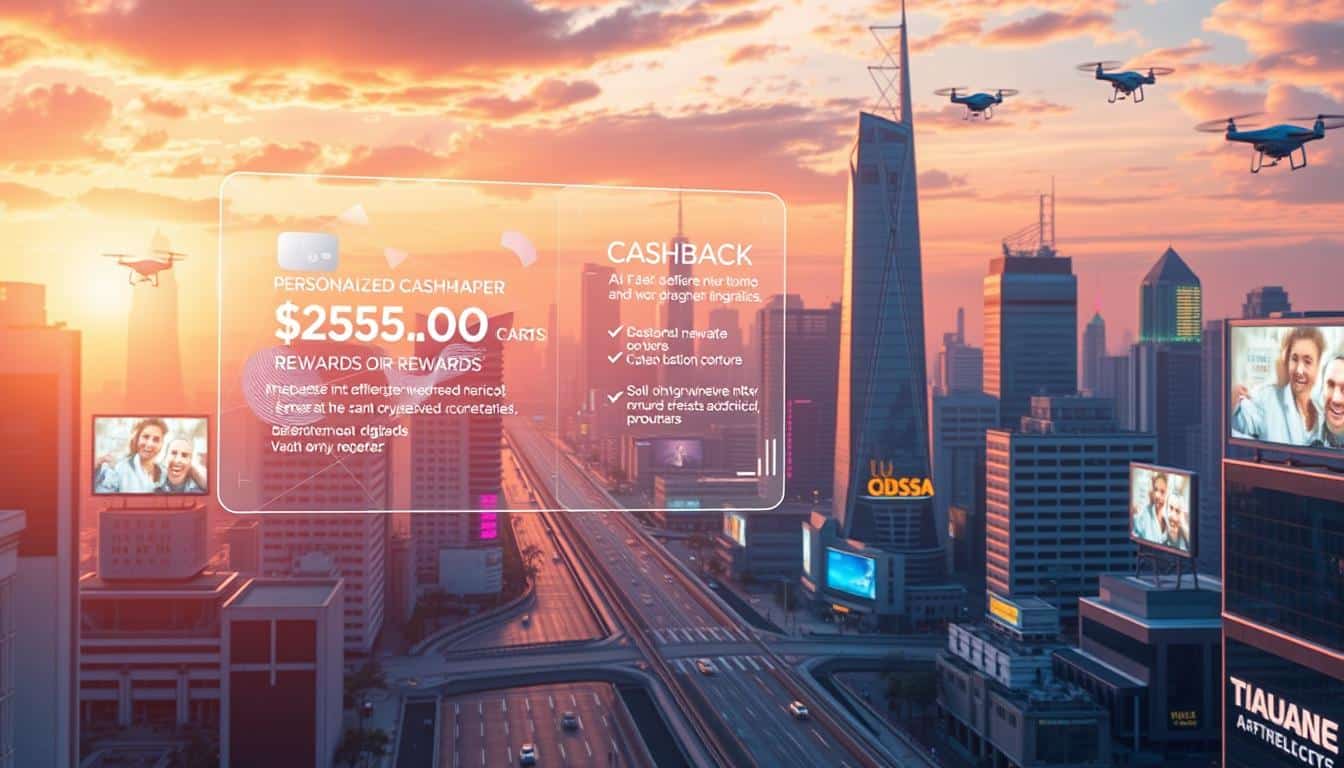The scene of economic growth is gearing up for a big change in 2025. As we explore the economic insights 2025, it’s clear that many moving parts will affect the United States and the world’s economy. It’s crucial for businesses, policymakers, and stakeholders to keep up by reviewing a detailed economic trends analysis.

TD Cash Back Visa Infinite* Card
This piece aims to blend top economic reports and forecasts. It offers vital information for making choices in this changing landscape.
Anúncios
Overview of Economic Growth Predictions for 2025
By 2025, economic growth looks set for a big change. The world may see growth slow down, with an expected rate of just 2.9%. This figure comes from Morgan Stanley and shows a notable drop from past years.
In the United States, the growth outlook is even more concerning, with a drop to 1.4% expected. Rising tariffs and lower spending due to less consumer confidence are to blame. These issues are part of a wider trend of slow growth seen across major economies. It’s the slowest since the COVID-19 pandemic ended.

Today’s global economy highlights the need for policy changes. As trade and fiscal conditions shift, new growth strategies are essential. They must boost growth and bring back investor trust in these uncertain times.
Key Influencers of Economic Growth
Trade policy changes and stability around the world are key to economic growth. The way countries interact impacts businesses and markets greatly. Knowing these factors helps with better decision-making for companies.
Trade Policy Changes
Trade policies are now a big factor shaking up the world’s economy. A survey shows that 36% of company leaders see trade changes, like tariffs, affecting their business. The concern over trade policy shifts has grown a lot since last year, says a McKinsey Global Survey. This shows that businesses must adapt their strategies to deal with new trade rules.
Geopolitical Stability
Stable geopolitics is also crucial for economic growth. Changes in stability can make investors unsure and affect how people spend money. When the world is stable, businesses feel good about expanding and entering new markets. But instability makes them cautious about spending. Knowing about these factors helps companies prepare for both challenges and opportunities globally.
Economic Growth Trends in the United States
The U.S. economy is facing slower growth rates, sparking doubts about future recovery. Analysts suggest a dip to around 1.4% growth by late 2025. This trend points to a slow growth phase due to several factors impacting the economy.
Slower Growth Rates
Reports show the economy’s momentum is dropping compared to past years. This slowdown comes from various sources, including:
- Immigration restrictions that limit workforce expansion.
- Trade policy uncertainties creating hesitance among businesses.
- Shifts in consumer spending patterns influenced by changing inflation rates.
These factors lead to cautious investment and spending, making the 2025 growth outlook less hopeful.
Inflation Contributing Factors
Inflation is putting pressure on the U.S. economy, affecting buying power and growth. Main causes include:
- Supply chain disruptions still impacting costs and availability of goods.
- Increased energy prices driven by geopolitical tensions.
- Labor shortages that elevate wage demands across industries.
These inflation causes make the economic future uncertain and suggest slow growth ahead.
Impact of Global Trade Policies on Economic Growth
Global trade policies shape our economy, affecting growth and creating challenges. Changes in tariffs have put businesses in a tough spot. This is especially true in the United States, where high tariffs raise costs for companies.
These tariff changes make the future of international trade talks unclear. This is a big deal for companies planning to grow by 2025. They have to think about how these policies will change their business. Changes can either open new doors or cause problems.
Because of this, planning ahead is crucial for businesses. Those who look into how policies might change are better at handling market changes. Understanding how trade influences growth is key to surviving in a tough economy.
Sector-Specific Growth Insights
Trends specific to technology and consumer services strongly shape economic growth. Businesses are paying close attention to how these areas can spur innovation. This, in turn, supports both immediate and long-term goals.
Technology and Innovation
Staying ahead in technology is key to overcoming today’s economic hurdles. A survey shows that 41% of business leaders are investing in artificial intelligence (AI). This is to boost efficiency and stay competitive.
By utilizing the latest tech, companies are refining their processes and creating innovative products.
Consumer Services
As consumer preferences change and new tech appears, the consumer services sector adapts. Offering better digital experiences is vital for keeping customers. Businesses that embrace these changes often see more loyalty and a bigger share of the market.
This helps fuel economic growth. Keeping an eye on consumer behavior is crucial for businesses wanting to succeed in changing economic landscapes.
Effect of Central Banks and Fiscal Policy on Economic Growth
Central banks play a crucial role in shaping economic growth. They do this by setting interest rates and monetary policies. In the U.S., the Federal Reserve plans to keep current interest rates steady until early 2026. This approach is different from other areas where easing measures might be preferred.
This strategy aims to keep the financial system stable while dealing with inflation.
Fiscal policy is also key in driving economic activity. In places like the U.S., Eurozone, and China, government spending is on the rise to boost growth. However, this increases worries about growing public deficits. It’s a tough job for policymakers to stimulate the economy and control inflation at the same time.
The joint effect of central banks and fiscal policy will shape the economic future. Finding the right balance is essential. It will help promote lasting growth and tackle financial challenges.
Strategies for Businesses in Navigating Economic Growth Challenges
Companies face many economic uncertainties today. To survive and grow, they must create strong strategies for adaptation. Changes in trade policy and global politics bring big risks. Organizations know it’s crucial to be flexible in their strategies. This flexibility helps them avoid dangers and grab new opportunities when they appear.
Importance of Adaptation and Flexibility
Being able to change and adjust is key in dealing with economic troubles. When businesses quickly respond to what the market wants, they stay ahead of others. Adding new products, entering different markets, and changing supply chains boost this flexibility. A forward-thinking approach to change makes a business strong and ready for the future.
Investment in Automation and AI
Putting money into automation and artificial intelligence (AI) is vital for modern business plans. These advances make work smoother and use resources better. Automation lets businesses keep up with changing demand. At the same time, AI offers deep insights into what customers want and market trends. Using these tools, companies can move with more speed and smarts through tough economic times.
Regional Economic Growth Variations
Global economics show big differences in growth, especially between North America and emerging markets. Different regions recover and grow at different rates due to unique challenges. North America deals with inflation and new trade policies, while emerging markets see growth from increased local demand.
North America vs. Emerging Markets
In North America, growth is slow because of inflation and trade doubts. The U.S. in particular faces big hurdles that might slow its economy. On the other hand, Asian emerging markets are booming. They benefit from more spending within their borders and more investments from other countries, making their growth outlook brighter.
These differences in economic growth have big effects. North American policymakers need to find solutions that work for their specific problems. Emerging markets should use this time to promote innovation and make it easier to enter their markets. For businesses wanting to thrive globally, understanding these regional differences is key.
Expectations for Inflation and Its Impact on Economic Growth
Inflation expectations are set to significantly shape our economic future in 2025. Predicted inflation trends will heavily influence how people spend and how companies plan. With rising tariffs and market shifts, manufacturing costs could go up, leading to changes in prices.
Looking closely at inflation for 2025 shows companies must improve how they operate to overcome economic growth challenges. Adjusting to higher prices is key to keeping profits up and staying competitive.
Grasping how inflation will move is vital for businesses trying to survive in a tough market. As prices climb, companies need smart plans to seize opportunities and handle the cost increases.
To conclude, preparing for inflation with smart strategies is crucial for U.S. businesses facing 2025’s hurdles. This will greatly influence their economic growth.
Business Leaders’ Insights on Economic Growth
Business leaders are worried about how trade policies and global issues might change economic predictions. They agree on the need to adjust to these challenges. They often focus on investing in technology, like artificial intelligence, to stay ahead.
Executives say using AI can solve current problems and also help businesses grow. They believe in using new technologies to keep their companies competitive.
Leaders are also ready to change their business models if necessary. They understand the market changes quickly. They’re committed to taking advantage of new opportunities.
Future Outlook for Global Economic Growth Trends
Economists and business leaders are worried about a possible recession in 2025. They say many factors are causing this concern. They stress on making strategic changes to lessen the risks of economic downturns.
Potential Recession Scenarios
By 2026, about 70% of business execs think a recession might hit by mid-year. The main reasons they see for this include:
- High tariff rates affecting trade dynamics
- Persistent inflation impacting consumer spending
- Global supply chain disruptions exacerbating market instability
Post-2025 Projections
After 2025, there’s hope for a careful recovery with the right moves. Experts suggest focusing on agile fiscal policies and tech innovations to keep growth steady. They believe the recession in 2025 could be a turning point for new economic plans.
Conclusion
The outlook for 2025 shows a mix of challenges and chances for growth. Stakeholders need to be very flexible and innovative. Because of issues like global tensions, changing trade rules, and rising prices, being adaptable is key.
Our summary highlights how crucial it is for companies and policy makers to make smart choices. They must tackle these complex problems with flexible plans. This approach will lead to stable and sustainable growth in a shifting market.
In the end, how well organizations adjust to change will shape their success. They must build resilience and keep innovating to thrive in the changing economy of 2025 and onward.
FAQ
What is the predicted U.S. economic growth rate for 2025?
How are global trade policies affecting economic growth?
What role does inflation play in predicted economic growth?
Which sectors are expected to drive growth despite economic uncertainties?
What fiscal policies are being implemented to stimulate economic activity?
How are businesses responding to economic uncertainties?
What is the difference in economic growth projections between North America and emerging markets?
Are there any concerns about potential recession scenarios?
Conteúdo criado com auxílio de Inteligência Artificial



